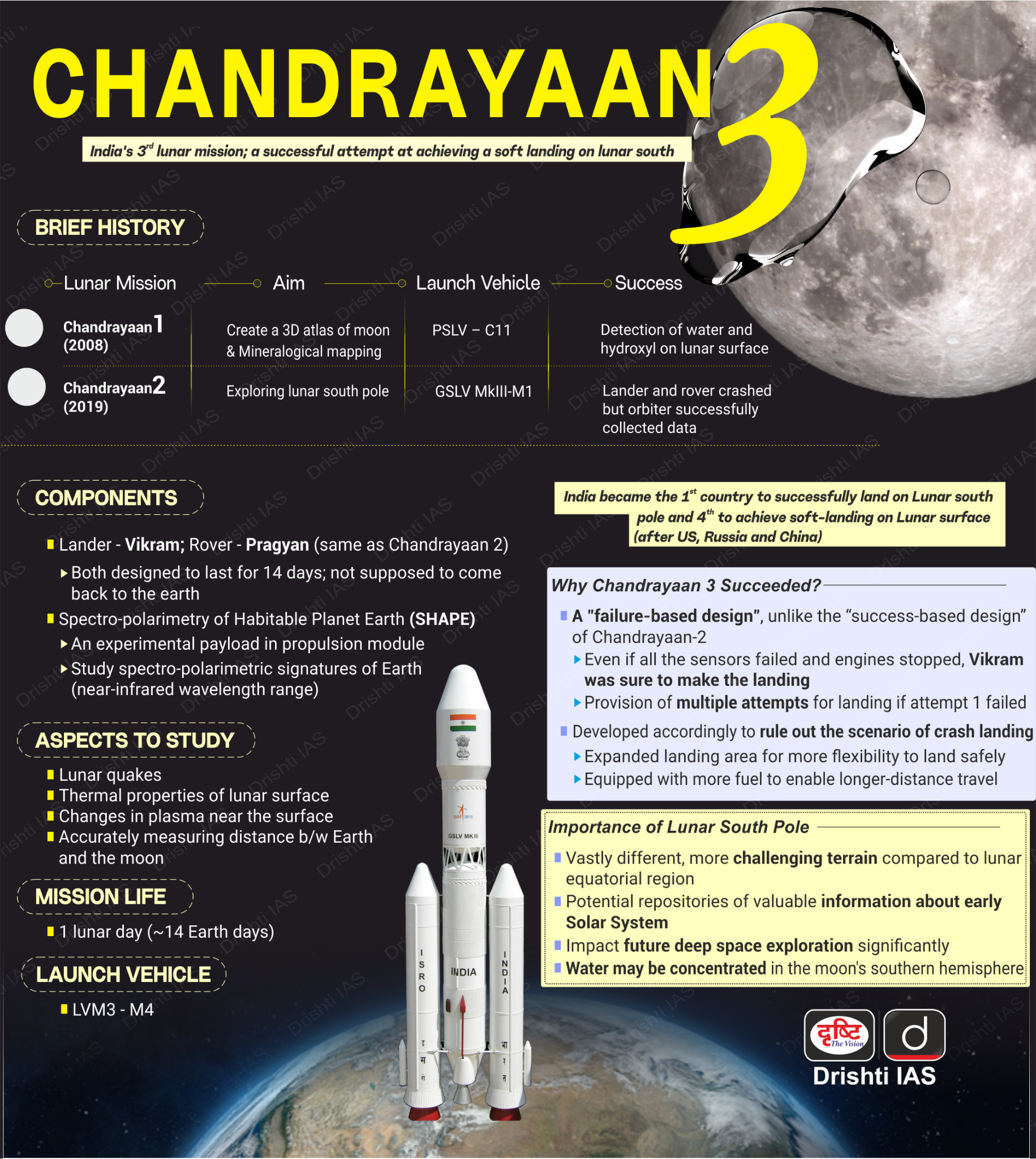-
10 Mar 2025
GS Paper 1
Current Affairs
Day 7: How do the objectives and significance of Chandrayaan-3 reflect India's space ambitions and global aspirations? (38 Marks)
Approach
- In the introduction briefly mention India's space ambitions and Chandrayaan-3’s significance.
- Highlight its objectives-soft landing, lunar research, and innovation.
- Discuss its role in self-reliance, global positioning, and cost-effective space missions.
- Conclude suitably.
Introduction
India's Chandrayaan-3 mission marks a significant milestone in its journey toward becoming a global space power. Launched by the Indian Space Research Organisation (ISRO), this mission demonstrates India's commitment to technological advancement, self-reliance, and leadership in space exploration. It aligns with India's long-term vision of strengthening its space capabilities while contributing to global scientific research.
Body
Objectives of Chandrayaan-3:
Chandrayaan-3 aimed to build on the learnings of its predecessor, Chandrayaan-2, and achieve a successful soft landing on the Moon’s South Pole, a region of immense scientific interest. The key goals included:
- Soft Landing Demonstration: Ensuring precise landing using indigenous technology.
- Rover Deployment: Deploying the Pragyan Rover for surface exploration.
- Lunar Surface Analysis: Conducting in-situ experiments to study soil composition, seismic activity, and temperature variations.
- Technological Advancement: Enhancing India’s capability in planetary exploration.
Significance in India’s Space Ambitions:
- Strengthening Technological Prowess: Chandrayaan-3 demonstrated India’s ability to execute complex space missions with indigenous technology, reaffirming Atmanirbhar Bharat (Self-Reliant India) in space exploration.
- Boosting Lunar Exploration Capabilities: The mission contributed to the study of water ice deposits, essential for future human settlements and deep-space missions.
- Enhancing Global Collaboration: By sharing scientific data, India contributes to international lunar research programs, positioning itself as a reliable space partner.
- Economic Growth and Commercial Prospects: Success in such missions strengthens India’s space economy, attracting private investment and fostering startups under the IN-SPACe and NewSpace India Limited (NSIL) initiatives.
Role in India's Global Space Aspirations:
- Fourth Country to Achieve Lunar Soft Landing: India joined the elite group of nations (USA, Russia, China) with this capability, enhancing its global standing.
- Leadership in Low-Cost Space Missions: With Chandrayaan-3 being one of the most cost-effective lunar missions, India showcases its ability to achieve advanced space exploration at a fraction of the cost compared to global counterparts.
- Advancing India’s Space Diplomacy: Strengthens India's role in international space programs and organizations like Artemis Accords, BRICS Space Cooperation, and the Global Space Economy.
- Paving the Way for Future Missions: Chandrayaan-3 lays the groundwork for Gaganyaan (India’s first human spaceflight program), Shukrayaan (Venus mission), and interplanetary explorations, reinforcing India's long-term space ambitions.
Way Forward:
- Sustaining Lunar Exploration: Develop Chandrayaan-4 with enhanced payloads for deep-space research.
- Strengthening International Collaborations: Expand partnerships with global space agencies for joint missions and knowledge exchange.
- Enhancing Technological Capabilities: Invest in next-generation propulsion, AI-based space robotics, and autonomous navigation for interplanetary travel.
- Boosting Commercial Space Sector: Encourage private-sector investments to scale satellite manufacturing, deep-space exploration, and space tourism.
Conclusion
Chandrayaan-3 is a testament to India’s growing stature in the global space arena. It reflects the nation’s scientific expertise, strategic vision, and commitment to space research. By successfully achieving its objectives, the mission has propelled India closer to its ambition of becoming a leading space power, driving innovation, economic growth, and international collaboration.





